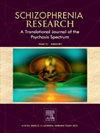作为精神分裂症现实监测缺陷的预测因子的受损的推论放电:对听觉言语幻觉的影响
IF 3.5
2区 医学
Q1 PSYCHIATRY
引用次数: 0
摘要
精神分裂症患者的听觉言语幻觉(AVH)与源监测任务中的现实监测(RM)障碍有关。然而,人们对其神经生物学基础知之甚少。推论放电(corcorative discharge, CD)是一种区分自我刺激和外部刺激的预测性神经机制,被认为是这些损伤的基础,有助于内部思想的外化偏见(EB)和AVH的发生。目的探讨持续性AVH精神分裂症患者CD信号传导与RM缺陷之间的关系。35名SZP和35名健康对照(hc)完成了一个评估CD信号的Talk/Listen范式和一个评估EB和内化偏倚(IB)的RM任务。记录听神经N1波幅的事件相关电位(ERPs),计算相应放电指数(CDI)。旧/新精度、EB和IB是由任务绩效得出的。回归分析CDI与EB的预测关系。结果sszp与HCs相比,CDI明显降低(p <;0.001),主要是由于在Talk条件下更多的负N1振幅;在聆听期间没有观察到显著差异。在RM任务中,患者表现出内部源识别受损和更高的EB (p <;0.001)。回归分析发现CDI是EB的显著预测因子(R2 = 0.128, p = 0.035)。结论CD信号受损至少在一定程度上导致精神分裂症患者RM缺陷和EB增加,这为AVH的神经生物学基础提供了新的见解。针对AVH的潜在治疗干预可以考虑纠正这些缺陷。本文章由计算机程序翻译,如有差异,请以英文原文为准。
Impaired corollary discharge as a predictor of reality monitoring deficits in schizophrenia: Implications for auditory verbal hallucinations
Background
Auditory verbal hallucinations (AVH) in schizophrenia are linked to reality monitoring (RM) impairment in source monitoring tasks. However, little is known about its neurobiological basis. Corollary discharge (CD), a predictive neural mechanism distinguishing self-generated from external stimuli, is hypothesized to underlie these impairments, contributing to the externalization bias of internal thoughts (EB) and the genesis of AVH.
Objective
We investigated the relationship between CD signalling and RM deficits in schizophrenia patients (SZP) with persistent AVH.
Methodology
Thirty-five SZP and 35 healthy controls (HCs) completed a Talk/Listen paradigm to evaluate CD signalling and an RM task to assess EB and internalization bias (IB). Event-related potentials (ERPs) of auditory N1 amplitudes were recorded, and the Corollary Discharge Index (CDI) was calculated. Old/New Accuracy, EB, and IB were derived from task performance. Regression analysis was conducted to find the predictive relationship between CDI and EB.
Results
SZP showed significantly reduced CDI compared to HCs (p < 0.001), primarily due to more negative N1 amplitudes during the Talk condition; no significant difference was observed during Listen. In the RM task, patients exhibited impaired internal source recognition and higher EB (p < 0.001). Regression analysis identified CDI as a significant predictor of EB (R2 = 0.128, p = 0.035).
Conclusion
Impaired CD signaling contributes, at least partly, to RM deficits and increased EB in schizophrenia, providing insight into the neurobiological underpinnings of AVH. Potential therapeutic interventions targeting AVH may consider correcting these deficits.
求助全文
通过发布文献求助,成功后即可免费获取论文全文。
去求助
来源期刊

Schizophrenia Research
医学-精神病学
CiteScore
7.50
自引率
8.90%
发文量
429
审稿时长
10.2 weeks
期刊介绍:
As official journal of the Schizophrenia International Research Society (SIRS) Schizophrenia Research is THE journal of choice for international researchers and clinicians to share their work with the global schizophrenia research community. More than 6000 institutes have online or print (or both) access to this journal - the largest specialist journal in the field, with the largest readership!
Schizophrenia Research''s time to first decision is as fast as 6 weeks and its publishing speed is as fast as 4 weeks until online publication (corrected proof/Article in Press) after acceptance and 14 weeks from acceptance until publication in a printed issue.
The journal publishes novel papers that really contribute to understanding the biology and treatment of schizophrenic disorders; Schizophrenia Research brings together biological, clinical and psychological research in order to stimulate the synthesis of findings from all disciplines involved in improving patient outcomes in schizophrenia.
 求助内容:
求助内容: 应助结果提醒方式:
应助结果提醒方式:


